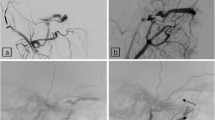Abstract
Introduction
Direct carotid-cavernous fistula (CCF) is a direct communication between the internal carotid artery (ICA) and the cavernous sinus. Some patients treated with detachable balloons develop pseudoaneurysms or present with a true aneurysm recanalization in the cavernous ICA with poorly known long-term radiological and clinical progression. The objective of the present study was to evaluate the long-term clinical and radiological progression of patients treated with detachable balloons.
Methods
The present study evaluated 13 patients previously treated for direct CCF by an endovascular approach.
Results
The follow-up period ranged between 19 and 128 months. Ophthalmological evaluation demonstrated alterations in eight patients (61.5%). All of these alterations were already present from the moment of the treatment and displayed no signs of progression. Cranial magnetic resonance imaging (MRI) and magnetic resonance angiography (MRA) were performed in all patients, and 11 pseudoaneurysms were demonstrated in ten of the 11 patients in whom ICA patency had been preserved. Five patients were submitted for cerebral digital subtraction angiography (DSA) to characterize the pseudoaneurysms previously observed on MRA studies, with no significant differences in morphology, size, aneurismal neck, and number of lesions.
Conclusion
Endovascular treatment of direct CCF with detachable balloons has been shown to be a long-term effective and stable therapeutic method. The authors found asymptomatic pseudoaneurysms in 91% of cases where the ICA patency was preserved. MRI and MRA demonstrated an accuracy similar to that of DSA in the diagnosis of pseudoaneurysms of cavernous ICA.


Similar content being viewed by others
References
Barrow DL, Spector RH, Braun IF, Landman JA, Tindall SC, Tindall GT (1985) Classification and treatment of spontaneous carotid-cavernous sinus fistulas. J Neurosurg 62:248–256
Serbinenko FA (1974) Balloon catheterization and occlusion of major cerebral vessels. J Neurosurg 41:125–145
Debrun GM, Viñuela F, Fox AJ, Davis KR, Ahn HS (1988) Indications for treatment and classification of 132 carotid-cavernous fistulas. Neurosurgery 22:285–289
Gupta AK, Purkayastha S, Krishnamoorthy T, Bodhey NK, Kapilamoorthy TR, Kesavadas C, Thomas B (2006) Endovascular treatment of direct carotid cavernous fistulae: a pictorial review. Neuroradiology 48:841–846
Lewis AI, Tomsick TTA, Tew JM Jr (1995) Management of 100 consecutive direct carotid-cavernous fistulas: results of treatment with detachable balloons. Neurosurgery 36:239–245
Caldas JGM, Valle BP, Ramos F Jr, Puglia P Jr, Cerri GG (1998) Endovascular treatment of traumatic and spontaneous direct carotidcavernous fistulas. Int J Neuroradiol 4:14–18
van Rooij WJ, Sluzewski M, Beute GN (2006) Ruptured cavernous sinus aneurysms causing carotid cavernous fistula: incidence, clinical, presentation and outcome. AJNR Am J Neuroradiol 27:185–189
Morón FE, Klucznik RP, Mawad ME, Strother CM (2005) Endovascular treatment of high-flow carotid cavernous fistulas by stent-assisted coil placement. AJNR Am J Neuroradiol 26:1399–1404
Kobayashi N, Miyachi S, Negoro M, Suzuki O, Hattori K, Kojima T, Yoshida J (2003) Endovascular treatment strategy for direct carotid-cavernous fistulas resulting from rupture of intracavernous carotid aneurysms. AJNR Am J Neuroradiol 24:1789–1796
Luo CB, Teng MMH, Chang FC, Chang CY (2006) Transarterial ballon-assisted n-butil-2-cyanoacrylate embolization of direct carotid cavernous fistulas. AJNR Am J Neuroradiol 27:1535–1540
Lewis AI, Tomsick TA, Tew JM Jr, Lawless MA (1996) Long-term results in direct carotid-cavernous fistulas after treatment with detachable balloons. J Neurosurg 84:400–404
Koh J-S, Kim G-K, Kim E-J, Lim Y-J, Rhee B-A, Kim T-S (2008) Serial angiographic evolution and regression of traumatic aneurysm of the internal carotid artery associated with a carotid-cavernous fistula. J Trauma 64:E76–E80
Higashida RT, Halbach VV, Tsai FY et al (1989) Interventional neurovasculartreatment of traumatic carotid and vertebral artery lesions: results in 234 cases. AJR 153:577–582
Higashida RT, Halbach VV, Dormandy B et al (1990) Endovascular treatment of intracranial aneurysms with a new silicone microballoon device: technical considerations and indications for therapy. Radiology 174:687–691
Saatci I, Cekirge HS, Ozturk MH, Arat A, Ergungor F, Sekerci Z et al (2004) Treatment of internal carotid artery aneurysms with a covered stent: experience in 24 patients with mid-term follow-up results. AJNR Am J Neuroradiol 25:1742–1749
Li MH, Gao BL, Wang YL, Fang C, Li YD (2006) Management of pseudoaneurysms in the intracranial segment of the internal carotid artery with covered stents specially designed for use in the intracranial vasculature: technical notes. Neuroradiology 48:841–846
Fiorella D, Albuquerque FC, Deshmukh VR, Woo HH, Rasmussen PA, Masaryk TJ et al (2006) Endovascular reconstruction with the neuroform stent as monotherapy for the treatment of uncoilable intradural pseudoaneurysms. Neurosurgery 59:291–300
Wahl WL, Brandt MM, Thompson BG, Taheri PA, MBA GLJ (2002) Antiplatelet therapy: an alternative to heparin for blunt carotid injury. J Trauma 52:896–901
Singh RR, Barry MC, Ireland A, Bouchier Hayes D (2004) Current diagnosis and management of blunt internal carotid artery injury. Eur J Vasc Endovasc Surg 27:577–584
Georgiadis D, Arnold M, von Buedingen HC, Valko P, Sarikaya H, Rousson V, Mattle HP, Bousser MG, Baumgartner RW (2009) Aspirin vs anticoagulation in carotid artery dissection: a study of 298 patients. Neurology 72:1810–1815
Timperman PE, Tomsick TA, Tew JM Jr, Van Loveren HR (1995) Aneurysm formation after carotid occlusion. ANJR Am J Neuroradiol 16:329–331
Gauvrit JY, Oppenheim C, Savage J, Nataf F, Reyns N, Pruvo JP et al (2005) Dynamic MRA in the evaluation of intracranial vascular diseases. J Neuroradiol 32:20–25
Anxionnat R, Bracard S, Lebedinsky A, Pinheiro N Jr, Iancu D, Roca F, Picard L (2008) A survey of the management of unruptured intracranial aneurysms as practised by French neuroradiological and neurosurgical teams. J Neuroradiol 35:90–98
Conflict of interest statement
We declare that we have no conflict of interest.
Author information
Authors and Affiliations
Corresponding author
Rights and permissions
About this article
Cite this article
Marques, M.C.P., Pereira Caldas, J.M., Nalli, D.R. et al. Follow-up of endovascular treatment of direct carotid-cavernous fistulas. Neuroradiology 52, 1127–1133 (2010). https://doi.org/10.1007/s00234-010-0683-8
Received:
Accepted:
Published:
Issue Date:
DOI: https://doi.org/10.1007/s00234-010-0683-8




